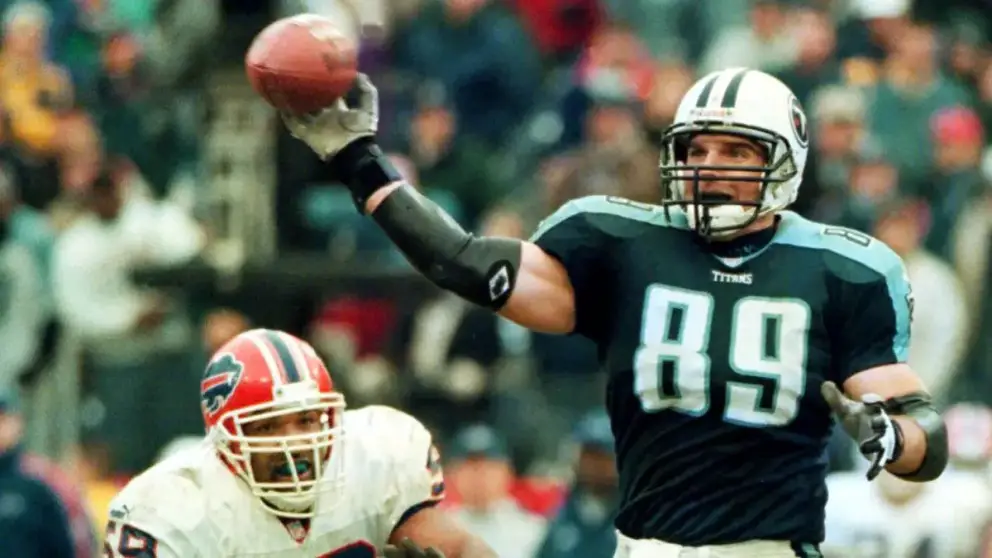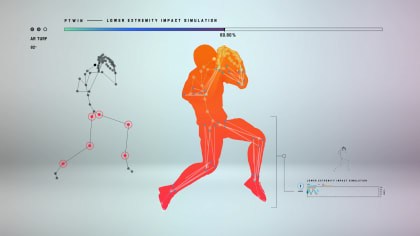In an era where technology and sports increasingly intersect, the National Football League (NFL) is pioneering the use of Artificial Intelligence (AI) to enhance player safety.
This article delves into how AI, particularly through the NFL’s Digital Athlete AI tool, is revolutionizing the way injuries, especially head injuries, are analyzed and prevented in professional football.
The Emergence of the Digital Athlete AI Tool: Understanding Its Functionality and Impact
Developed in collaboration with Amazon Web Services, the NFL’s Digital Athlete AI tool represents a significant leap in sports technology. This virtual representation of NFL players, powered by AI and machine learning, simulates numerous game scenarios.
Integrating data from sensors in helmets, mouth guards, and shoulder pads, along with game footage, it offers an in-depth analysis of injuries, paving the way for effective prevention strategies.
→ The Revolution of Artificial Intelligence in Healthcare and Medicine
Transforming Player Health and Safety
The Digital Athlete AI tool is more than just a technological advancement; it’s a paradigm shift in sports science.
By running simulations of various in-game scenarios, the tool can assess the impact of different equipment, weather conditions, and even playing surfaces on player safety.
This approach is not only about understanding injuries after they happen but also about predicting and preventing them, marking a significant step forward in player health and safety.
→ Utilizing AI to Enhance Fall Prevention for the Elderly: Promoting Safety and Autonomy
NFL’s Rule Changes for Injury Prevention: Recent Modifications
In conjunction with the technological advancements, the NFL has been proactive in modifying its game rules to reduce injuries.
Recent years have seen changes such as adjustments to kickoff rules, the expansion of defenseless player protection, and the prohibition of certain dangerous techniques like chop blocks and horse collar tackles.
These changes demonstrate the league’s commitment to evolving the game for the safety of its players.
→ Does Illness Impact Caloric Expenditure? An Investigation
The Impact of Rule Changes on Game Safety
The NFL’s rule changes have been instrumental in reducing the frequency and severity of injuries, particularly head injuries.
By altering the game’s structure and penalizing unsafe play, the NFL has created a safer environment for players, balancing the competitive nature of the sport with the necessity of player protection.
The Significance of Head Injury Prevention: Addressing a Critical Health Concern

Head injuries don’t only affect the teams but are very dangerous, as evidenced in the cases of the more than 150 Arizona players included in the concussion lawsuit against the NFL.
These injuries have long-term implications on player health, making their prevention a top priority for the league. The integration of AI tools like the Digital Athlete is a critical step in understanding and mitigating the risks associated with head trauma.
Frank Wycheck and CTE Issues

Frank Wycheck was a talented tight end who played in the NFL, most notably for the Tennessee Titans. His career spanned from 1993 to 2003, during which he became known for his reliability and skill on the field.
CTE Concerns
After retiring, Wycheck spoke openly about his struggles with symptoms consistent with chronic traumatic encephalopathy (CTE), a brain condition associated with repeated head traumas. CTE can lead to symptoms like memory loss, confusion, impaired judgment, aggression, depression, anxiety, impulse control issues, and sometimes suicidal behavior.
Advocacy and Awareness
Wycheck was vocal about the risks of concussions and head injuries in football, contributing to the broader conversation about player safety in the NFL. His personal experiences highlighted the long-term impacts of the physical demands of professional football.
The Music City Miracle Hero
The Music City Miracle refers to a famous play during the 1999 NFL Playoffs. It occurred on January 8, 2000, in a Wild Card Round game between the Buffalo Bills Tennessee Titans.
With just 16 seconds left in the game and the Titans trailing 16-15 after Steve Christie’s 41-yard field goal, they ran a play called “Home Run Throwback.” The Bills kicked off to the Titans. Fullback Lorenzo Neal caught the kick but handed Wycheck the ball around the 25. He then threw a lateral pass across the field to Kevin Dyson, who ran 75 yards down the sideline for a touchdown, stunning the Bills and everyone watching.
The play is one of the most memorable and controversial in NFL history. It was controversial because of the debate over whether Wycheck’s pass was a legal lateral or an illegal forward pass. After review, officials ruled it a legal lateral, confirming Tennessee’s 22-16 win and solidifying the play’s legendary status.
While local betting apps weren’t yet legal during the Music City Miracle, millions of Titans fans and sports bettors will never forget Wycheck’s miraculous play.
The NFL’s approach to managing and preventing head injuries has evolved significantly over the years. The combination of technological innovations and rule changes implemented by the NFL is part of a comprehensive strategy to decrease the chances of brain trauma, but there still a long way to go. This is crucial in safeguarding the long-term health and well-being of players.
Data Integration and Analysis in Injury Prevention: Harnessing Big Data for Player Safety
The Digital Athlete AI tool represents a significant advancement in the use of big data for injury prevention. By analyzing vast amounts of data from sensors and game footage, the tool can identify patterns and risk factors that were previously undetectable. This approach allows for a more nuanced understanding of how injuries occur and how they can be prevented.
The Role of Machine Learning and AI
Machine learning and AI are at the heart of the Digital Athlete, enabling the system to learn from each play and continuously improve its predictive accuracy. This capability is vital in developing strategies that can effectively reduce the incidence of injuries, particularly head injuries, in the NFL.
The Future of AI in Sports: Expanding Beyond the NFL
The success of the Digital Athlete AI tool in the NFL opens up possibilities for its application in other sports. The principles of injury prevention and player safety are universal, and the use of AI can be a game-changer in protecting athletes across various disciplines.
Innovating for Safer Sports Environments
As AI technology continues to evolve, its potential to transform sports health and safety is immense. Future developments could include real-time injury risk analysis, customized player training programs, and more effective protective gear, all driven by AI’s predictive power.
Conclusion: A New Era in Sports Safety

The NFL‘s adoption of AI for injury prevention, particularly the Digital Athlete AI tool, marks a new era in sports safety. By combining technology with thoughtful rule changes, the league is setting a standard for protecting athletes.
As these technologies continue to develop, their impact on sports health and safety will likely grow, paving the way for a safer, more sustainable future in athletics.
